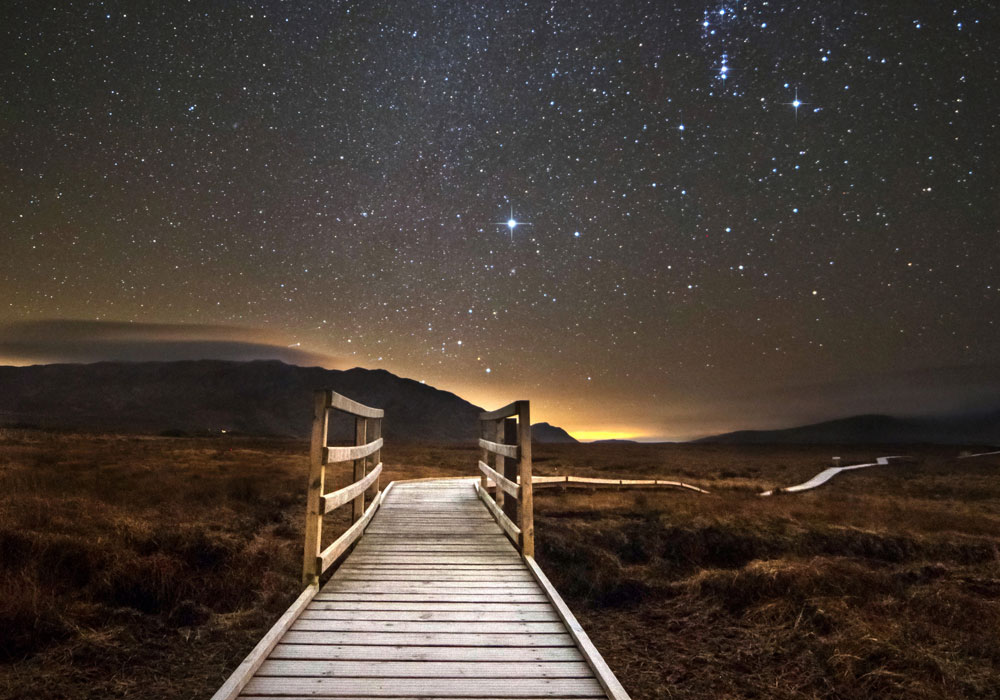The uninterrupted panoramic skies of Ireland’s Dark Sky Reserves are the perfect spot for star gazing.
Star gazing is increasingly popular all around the world. Not stargazing on Instagram or the latest gossip blog type, but genuine staring into the sky Star gazing. Sleeping out under the skies full of wonder. Perhaps as the world becomes a seemingly more troubled place, the calm and infinite beauty of the universe above us is more and more enticing and enchanting.
The prolific and widespread use of artificial light at night has meant that millions of children world-wide have never seen a sky full of stars. They have never experienced the simple and magical joy of constellations, planets, meteorites and space stations. Never tried to point out the ‘Plough’, the Milky-way or the ‘Seven Sisters’. Light pollution from cities and towns makes it so difficult to experience the full beauty of a starry sky. It is a rare and wonderful thing for many. In Ireland, it is always wonderful, but not so rare. Ireland is one of the best places for star gazing and boasts two dark sky reserves, dedicated to seeing the sky in all its glory, without interference. Clouds are the only issue in viewing the sky at night.
Ireland has the honour of being the only country in the Northern Hemisphere that can boast two Gold Tier dark sky reserves. A dark sky reserve is essentially an area designated to avoiding light pollution and keeping an unspoilt environment. The Kerry Dark Sky Reserve is 700 sq. kilometres of amazing protected land and skies hugging the Atlantic Ocean, while Mayo’s Dark Sky Park, and is nestled near Nephin Mountain and an area of awesome natural beauty. This makes Ireland one of the most appealing and rewarding destinations for dedicated star gazers. There are over 4,500 twinkling stars visible to the naked eye. There are the identifiable planets in our solar system, The Milky Way and even meteor showers to enjoy with the naked eye. A growing number of people are choosing to sleep below the stars and enjoy this unique experience. In many cases, our wilderness already has a great many places where the night skies are viewed unimpaired by any distraction from below. Donegal coastline has been a perfect place to view Northern Lights over the past few years. Parts of Sligo, Clare and Antrim also offer vast clear sky views across the Atlantic Ocean guaranteed to reconnect us with the natural beauty of the night, inspiring creativity. But the designated Dark Sky Reserves are protected for the future.
Since 1988, the International Dark-sky Association, a non-profit organisation based in the USA have been promoting ways to preserve and protect dark sky regions. There are designated reserves in Namibia, New Zealand, Snowdonia in Wales and Quebec in Canada, among others. The preservation of night time environments is not just about assisting humans to see the wonders that are above. It is also about human health, preserving wildlife and the environment. Plants and animals depend on the daily cycle of light and dark, the earthly rhythms to govern life-sustaining behaviours such as reproduction, nourishment, sleep and protection from predators. Artificial light disrupts their nocturnal activities and it is thought to have an adverse effect on breeding and the fore contributes to reducing populations of creatures, such as toads and frogs, alongside mammals, insects, birds and even plants. Predators also use the man made light to hunt animals that traditionally hid in the darkness of the night. Scientific evidence also suggests that artificial light at night has negative and deadly effects on bird migrating. Confusing birds into migrating too early or too late.
Research also suggests that false man made light at night has a negative effect on humans. Similar to most life on Earth, humans are linked to a circadian rhythms or a biological clock. The sleep-wake pattern governed by the day-night cycle may be severely disrupted by artificial light and so, has been linked to obesity, depression, sleep disorders, diabetes and other scary illnesses. Of course, there is also the links to wasting energy, which in turn, has a detrimental effect on the environment. It is estimated that over an average year in the U.S. outdoor lighting uses about 120 terawatt-hours of energy, mostly to illuminate streets and car parks. That’s enough energy to meet New York City’s total electricity needs for two years! Turn it off folks and let’s step into the dark. If that doesn’t have you rushing to turn off the outside lights, then nothing will. But reach for the tent and sleeping bag too, and plan a trip that includes this wonderful, free and awe-inspiring beauty that is on our doorsteps in Ireland. The Irish Dark Sky reserves are rated as Gold Tier, in international ranking. This makes us the only country in the Northern Hemispheres with two Top rated reserves.
There are only good and worthy reasons why we should be out in our sleeping bags, having outdoor adventures under a blanket of stars. It is better for the environment, for the bats, the owls, the mice and the toads. It is better for the climate. Ultimately, though, it is better for us too. So, consider an expedition to one of Ireland’s best kept dark skies secrets and add star gazing to your list of adventures this year. For added ‘oomph’, plan to coincide with a meteor shower. Meteor showers generally occur from November to March and timing and projected weather conditions can be checked on the Astronomy Ireland website in advance. Of course, warm clothes, decent camping gear and an intrepid spirit is needed. The rewards are immeasurable and are waiting… just above your head.
References:
https://www.independent.ie/editorial/StoryPlus/be-captivated-by-kerrys-dark-sky-reserve/
http://www.mayodarkskypark.ie/

